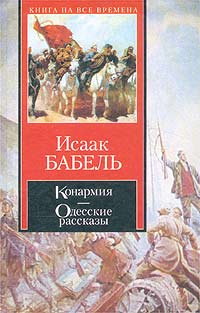
Red Cavalry
Encyclopedia

Isaac Babel
Isaak Emmanuilovich Babel was a Russian language journalist, playwright, literary translator, and short story writer. He is best known as the author of Red Cavalry, Story of My Dovecote, and Tales of Odessa, all of which are considered masterpieces of Russian literature...
about the 1st Cavalry Army
1st Cavalry Army
The 1st Cavalry Army was the most famous Red Army сavalry formation. It was also known as Budyonny's Cavalry Army or simply as Konarmia ....
. The stories take place during the Polish-Soviet war
Polish-Soviet War
The Polish–Soviet War was an armed conflict between Soviet Russia and Soviet Ukraine and the Second Polish Republic and the Ukrainian People's Republic—four states in post–World War I Europe...
and are based on Babel's own diary, which he maintained when he was a journalist assigned to the Semyon Budyonny
Semyon Budyonny
Semyon Mikhailovich Budyonny , sometimes transliterated as Budennyj, Budyonnyy, Budennii, Budenny, Budyoni, Budyenny, or Budenny, was a Soviet cavalryman, military commander, politician and a close ally of Soviet leader Joseph Stalin.-Early life:...
's First Cavalry Army
1st Cavalry Army
The 1st Cavalry Army was the most famous Red Army сavalry formation. It was also known as Budyonny's Cavalry Army or simply as Konarmia ....
.
First published in the 1920s, the book was one of the Russian people's first literary exposures to the dark, bitter reality of the war. During the 1920's writers of fiction like Babel were given a relatively good degree of freedom compared to the mass censorship and totalitarianism that would follow Stalin's ascent to power, and certain levels of criticism could even be published. But many of the stories were later banned in the USSR until the 1980s, as they contain undertones critical of the Revolution.
On the advice of Maxim Gorky
Maxim Gorky
Alexei Maximovich Peshkov , primarily known as Maxim Gorky , was a Russian and Soviet author, a founder of the Socialist Realism literary method and a political activist.-Early years:...
, the young Babel, his literary career only beginning, set off to join the Soviet Red Cavalry as a war correspondent and propagandist. The legendary violence of the Red Cavalry, present in Babel's writings, seemed to harshly contrast the gentle nature of the young writer from Odessa
Odessa
Odessa or Odesa is the administrative center of the Odessa Oblast located in southern Ukraine. The city is a major seaport located on the northwest shore of the Black Sea and the fourth largest city in Ukraine with a population of 1,029,000 .The predecessor of Odessa, a small Tatar settlement,...
. This contrast is also apparent in stories like "My First Goose," where the narrator, on account of his glasses, must prove himself worthy of his fellow soldier's camaraderie (and deny his 'intellectuality') by brutally killing a goose and ordering a woman to cook it.
Anti-Semitism
Anti-Semitism
Antisemitism is suspicion of, hatred toward, or discrimination against Jews for reasons connected to their Jewish heritage. According to a 2005 U.S...
is another major theme dealt with in the book. Babel chronicles how both the Red
Red Army
The Workers' and Peasants' Red Army started out as the Soviet Union's revolutionary communist combat groups during the Russian Civil War of 1918-1922. It grew into the national army of the Soviet Union. By the 1930s the Red Army was among the largest armies in history.The "Red Army" name refers to...
and White Armies, while fighting each other, would also both commit horrible atrocities against the Jews in the old Jewish Pale, leading Gedali, a Jewish shopkeeper to famously ask, "which is the Revolution and which the counterrevolution?" In stories like "Gedali," the narrator is forced to confront his dual, seemingly contradictory nature as both a Jew and a fighter for the Revolution.
The book contains references to actual people who, unbeknownst to Babel at the time, would later emerge as prominent figures in the Soviet Union. These include Semyon Budyonny
Semyon Budyonny
Semyon Mikhailovich Budyonny , sometimes transliterated as Budennyj, Budyonnyy, Budennii, Budenny, Budyoni, Budyenny, or Budenny, was a Soviet cavalryman, military commander, politician and a close ally of Soviet leader Joseph Stalin.-Early life:...
, Kliment Voroshilov
Kliment Voroshilov
Kliment Yefremovich Voroshilov , popularly known as Klim Voroshilov was a Soviet military officer, politician, and statesman...
and Semyon Timoshenko
Semyon Timoshenko
Semyon Konstantinovich Timoshenko was a Soviet military commander and senior professional officer of the Red Army at the beginning of the German invasion of the Soviet Union in 1941.-Early life:...
(called "Pavlichenko" in the book), all of whom would later become Marshals of the Soviet Union
Marshal of the Soviet Union
Marshal of the Soviet Union was the de facto highest military rank of the Soviet Union. ....
and close allies of Stalin with considerable power.
Bibliographic information
- Конармия
- Isaac BabelIsaac BabelIsaak Emmanuilovich Babel was a Russian language journalist, playwright, literary translator, and short story writer. He is best known as the author of Red Cavalry, Story of My Dovecote, and Tales of Odessa, all of which are considered masterpieces of Russian literature...
, Red Cavalry , W. W. Norton & Company, 2003, ISBN 0-393-32423-0. (Google Books link)

